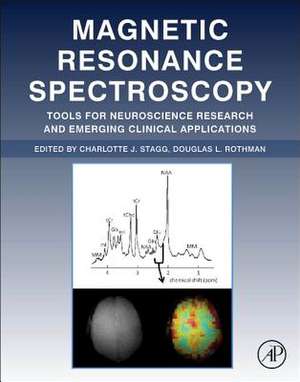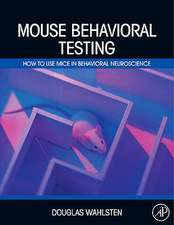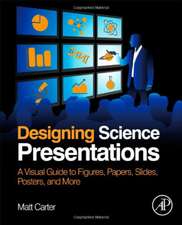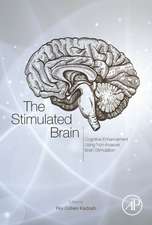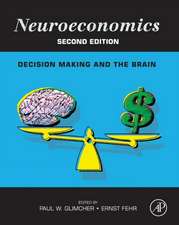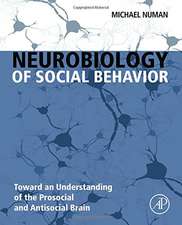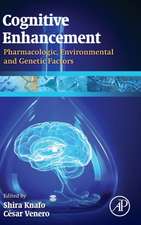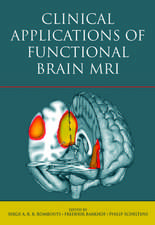Magnetic Resonance Spectroscopy: Tools for Neuroscience Research and Emerging Clinical Applications
Editat de Charlotte Stagg, Douglas L. Rothmanen Limba Engleză Hardback – 17 ian 2014
Magnetic Resonance Spectroscopy will become the essential guide for people new to the technique and give those more familiar with MRS a new perspective.
- Chapters written by world-leading experts in the field
- Fully illustrated
- Covers both proton and non-proton MRS
- Includes the background to novel MRS imaging approaches
Preț: 685.86 lei
Preț vechi: 804.34 lei
-15% Nou
Puncte Express: 1029
Preț estimativ în valută:
131.26€ • 136.53$ • 108.36£
131.26€ • 136.53$ • 108.36£
Carte tipărită la comandă
Livrare economică 07-21 aprilie
Preluare comenzi: 021 569.72.76
Specificații
ISBN-13: 9780124016880
ISBN-10: 012401688X
Pagini: 398
Ilustrații: black & white illustrations, colour illustrations, black & white line drawings, colour line drawings, colour tables, figures
Dimensiuni: 216 x 276 x 23 mm
Greutate: 1.27 kg
Editura: ELSEVIER SCIENCE
ISBN-10: 012401688X
Pagini: 398
Ilustrații: black & white illustrations, colour illustrations, black & white line drawings, colour line drawings, colour tables, figures
Dimensiuni: 216 x 276 x 23 mm
Greutate: 1.27 kg
Editura: ELSEVIER SCIENCE
Public țintă
Neuroscience researchers and clinicians (neurologists, radiologists, psychiatrists) using MR imagingCuprins
Section 1: Technical Aspects - How MRS Is Acquired
1.1 Basis of Magnetic Resonance
1.2 Localized Single-Voxel Magnetic Resonance Spectroscopy, Water Suppression, and Novel Approaches for Ultrashort Echo-Time Measurements
1.3 Technical considerations for Multivoxel Approaches and Magnetic Resonance Spectroscopic Imaging
1.4 Spectral Editing and 2D NMR
1.5 Spectral Quantification and Pitfalls in Interpreting Magnetic Resonance Spectroscopic Data: What to Look Out For
Section 2: Biochemistry - What Underlies the Signal?
2.1 N-Acetylaspartate and N-Acetylaspartylglutamate in Central Nervous System Health and Disease
2.2 The Biochemistry of Creatine
2.3 The Biochemistry of Choline
2.4 Glutamate
2.5 Other Significant Metabolites: Myo-Inositol, GABA, Glutamine, and Lactate
Section 3: Applications of Proton-MRS
3.1 Usefulness of Proton Magnetic Resonance Spectroscopy in the Clinical Management of Brain Tumors
3.2 Multiple Sclerosis and Inflammatory Diseases
3.3 Epilepsy
3.4 Stroke and Cerebral Ischaemia
3.5 Use of MRS in Inborn Errors of Metabolism: Canavan’s Disease and MRS in Differential Diagnosis
3.6 MRS of Psychiatric Disorders
3.7 Preclinical and Clinical Applications of 1H-MRS in the Spinal Cord
3.8 Interindividual Differences in Behavior and Plasticity
3.9 MRS in Development and Across the Lifespan
3.10 Hormonal Influences on Magnetic Resonance Spectroscopy Measures
3.11 Magnetic Resonance Spectroscopy in Neuroenergetics and Neurotransmission
Section 4: Applications of Non-Proton MRS
4.1 Quantitative Metabolic Magnetic Resonance Imaging of Sodium, Oxygen, Phosphorus, and Potassium in the Human Brain: A Rationale for Bioscales in Clinical Applications
4.2 Carbon (13C) MRS
4.3 Hyperpolarized Magnetic Resonance Imaging and Spectroscopy of the Brain
1.1 Basis of Magnetic Resonance
1.2 Localized Single-Voxel Magnetic Resonance Spectroscopy, Water Suppression, and Novel Approaches for Ultrashort Echo-Time Measurements
1.3 Technical considerations for Multivoxel Approaches and Magnetic Resonance Spectroscopic Imaging
1.4 Spectral Editing and 2D NMR
1.5 Spectral Quantification and Pitfalls in Interpreting Magnetic Resonance Spectroscopic Data: What to Look Out For
Section 2: Biochemistry - What Underlies the Signal?
2.1 N-Acetylaspartate and N-Acetylaspartylglutamate in Central Nervous System Health and Disease
2.2 The Biochemistry of Creatine
2.3 The Biochemistry of Choline
2.4 Glutamate
2.5 Other Significant Metabolites: Myo-Inositol, GABA, Glutamine, and Lactate
Section 3: Applications of Proton-MRS
3.1 Usefulness of Proton Magnetic Resonance Spectroscopy in the Clinical Management of Brain Tumors
3.2 Multiple Sclerosis and Inflammatory Diseases
3.3 Epilepsy
3.4 Stroke and Cerebral Ischaemia
3.5 Use of MRS in Inborn Errors of Metabolism: Canavan’s Disease and MRS in Differential Diagnosis
3.6 MRS of Psychiatric Disorders
3.7 Preclinical and Clinical Applications of 1H-MRS in the Spinal Cord
3.8 Interindividual Differences in Behavior and Plasticity
3.9 MRS in Development and Across the Lifespan
3.10 Hormonal Influences on Magnetic Resonance Spectroscopy Measures
3.11 Magnetic Resonance Spectroscopy in Neuroenergetics and Neurotransmission
Section 4: Applications of Non-Proton MRS
4.1 Quantitative Metabolic Magnetic Resonance Imaging of Sodium, Oxygen, Phosphorus, and Potassium in the Human Brain: A Rationale for Bioscales in Clinical Applications
4.2 Carbon (13C) MRS
4.3 Hyperpolarized Magnetic Resonance Imaging and Spectroscopy of the Brain
Recenzii
"Specialists in the neurosciences and in Magnetic Resonance Specctroscopy technology present a reference of the imaging technology for neurologists, psychiatrists, radiologists, and neuroscientists…The areas covered are technical aspects - how MRS is acquired, biochemistry - what underlies the signal, and applications of proton and non-proton MRS." --ProtoView.com, April 2014
